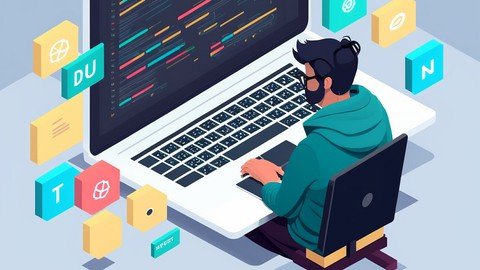Introduction To Backend Development With Kotlin & Micronaut

Introduction To Backend Development With Kotlin & Micronaut
Published 5/2023
MP4 | Video: h264, 1280x720 | Audio: AAC, 44.1 KHz
Language: English | Size: 2.33 GB | Duration: 3h 51m
Learn how to build fast, Lightweight and reactive applications with Micronaut, Kotlin, Redis, JDBC/JOOQ, and Kafka
What you'll learn
How to set up a development environment for Micronaut
How to Building a simple REST API
Test driven development, Unit & Integration Testing
Integrate with a database using Micronaut Data-JDBC
Integrate with a database using JOOQ
Integrate with Apache Kafka using Micronaut Kafka
Integrate with Redis, and Cache an endpoint.
Integrate with MongoDB, and perform common operations.
Requirements
Knowledge of the Kotlin programming language (optional)
Familiarity with SQL and database management systems.
Understanding of microservices architecture and RESTful API design
Exposure to Kafka and message-based systems (optional but recommended)
Familiarity with Dependency Injection (optional)
Description
In this course, you will learn how to use Micronaut and Kotlin to create fast, lightweight and reactive web applications. Micronaut is a modern framework for building microservices and serverless applications with Kotlin. It offers compile-time dependency injection, AOP, configuration management, HTTP client and server, and GraalVM support. Kotlin is a concise and expressive language that runs on the JVM and can interoperate with Java. It offers many features that make web development easier and more enjoyable, such as null safety, data classes, coroutines, extension functions, and DSLs.You will explore the main features and benefits of Micronaut and Kotlin through a series of hands-on exercises. You will learn how to create REST APIs with Micronaut and test your applications with Micronaut Test and JUnit 5. You will also learn how to use Micronaut Data to interact with relational (E.g. MySQL/Postgres) and non-relational (E.g., MongoDB) databases. This course is suitable for developers who have some basic knowledge of Kotlin and web development, as well as those who want to explore new frameworks and tools. By the end of this course, you will have a solid understanding of how to use Micronaut and Kotlin to create scalable and resilient web applications.
Overview
Section 1: Introduction
Lecture 1 Introduction
Lecture 2 Creating a Micronaut Project
Section 2: Introduction to Micronaut Controllers
Lecture 3 Controller Routes
Lecture 4 Controller Test
Section 3: Micronaut Configuration
Lecture 5 Micronaut Configuration basics
Section 4: Data Persistence and Controller Basic
Lecture 6 Entities and Data Transfer Objects
Lecture 7 Repositories Save - Memory database
Lecture 8 Repository Test
Lecture 9 Repository List - Memory database
Lecture 10 Repository Update - Memory database
Lecture 11 Repository Delete - Memory database
Section 5: Controllers
Lecture 12 Controller GET
Lecture 13 Controller Save
Lecture 14 Controller POST implementation
Lecture 15 Controller PUT Test
Lecture 16 Controller PUT Implementation
Lecture 17 Controller DELETE Test
Lecture 18 Controller DELETE Implemenation
Lecture 19 Controller GET (List) Test
Lecture 20 Controller GET (List) Implementation
Section 6: Flyway Setup
Lecture 21 Add database and Setup flyway
Section 7: Micronaut Data JDBC
Lecture 22 Database access with JDBC
Lecture 23 Serving DB data via controller/jdbc
Section 8: JOOQ integration
Lecture 24 Setup and configure Jooq
Lecture 25 Configuring Jooq db connection
Lecture 26 Repository - save, findbyId
Lecture 27 Repository List with JOOQ
Lecture 28 Jooq repository update
Lecture 29 JOOQ repository delete
Lecture 30 Jooq repository delete all
Lecture 31 Controller get with jooq repository
Section 9: Redis Integration
Lecture 32 Redis setup and configuration
Lecture 33 Redis Caching
Section 10: Kafka Integration
Lecture 34 Kafka Setup and Configuration
Lecture 35 Kafka Client
Lecture 36 Kafka Listener
Lecture 37 Kafka Integration testing
Lecture 38 Kafka Processing
Lecture 39 Kafka Processing Test
Section 11: Mongo Integration
Lecture 40 MongoDb setup and configuration
Lecture 41 MongoDb basics
Developers who want to learn how to use Micronaut and Kotlin to create fast, lightweight and reactive web applications.,Developers who are interested in learning about data management and repository development in Micronaut with Kotlin,Beginners who have some basic knowledge of Kotlin and web development,Intermediate or advanced developers who want to explore new frameworks and tools.
HOMEPAGE
https://www.udemy.com/course/introduction-to-backend-development-with-kotlin-micronaut/ DOWNLOAD
https://rapidgator.net/file/0c5ef6cb28d6c3863f5c2aad8d7f2867/Introduction_to_Backend_development_with_Kotlin_Micronaut.part1.rar.html
https://rapidgator.net/file/351e57c1a51db95c24144279686bc0de/Introduction_to_Backend_development_with_Kotlin_Micronaut.part2.rar.html
https://rapidgator.net/file/ddd9fbd84d165a5a87a0da819d8d9427/Introduction_to_Backend_development_with_Kotlin_Micronaut.part3.rar.html
https://uploadgig.com/file/download/d1c2eFb2f4f9db32/Introduction_to_Backend_development_with_Kotlin_Micronaut.part1.rar
https://uploadgig.com/file/download/1d9675103993ed7a/Introduction_to_Backend_development_with_Kotlin_Micronaut.part2.rar
https://uploadgig.com/file/download/81E7D5d7D87395B0/Introduction_to_Backend_development_with_Kotlin_Micronaut.part3.rar
